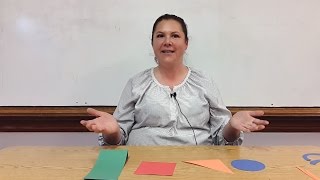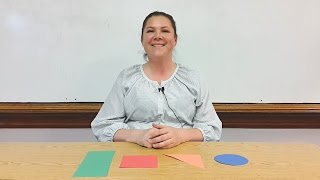This video describes children’s experience with shapes in their environment and their ability to recognize, name and describe a shape’s attributes. This video is part of a series describing children’s early mathematical development and showing how professionals can support this development during play, in daily routines, and through explicit teaching.
See supporting materials and related videos at http://www.easternct.edu/cece/elds-math-geometry/.
Copyright 2016 by the Connecticut Office of Early Childhood. Produced by the Center for Early Childhood Education at Eastern Connecticut State University. This video may only be used for educational purposes.
Read Transcript
Dr. Sudha Swaminathan: “Toddlers are very conscious of space. They try to fit things into others, and they quickly realize when something doesn’t fit. They might purposefully turn things around, so they fit or look similar to other shapes in that environment. So, in many ways, geometry is the first mathematical concept that a young child learns. An important and very natural part in geometry is shape recognition. And as children interact with shapes, they start to realize that some shapes have common features. They also start to understand that shapes have names. It’s equally important for them to recognize the attributes of a shape. For instance, corners, sides, number of sides. Initially children describe a shape visually.” Child: “Like a door.” Teacher: “It is like a door.” Dr. Sudha Swaminathan: “But gradually, they move away from the visual description to a more attribute-based description. And we want to encourage that. Teacher: “How do you know?” Child: “It has three sides.” Teacher: “It has three sides.” Dr. Sudha Swaminathan: “We want to make sure they have opportunities to interact with both two- and three-dimensional objects, to recognize that they both have distinct features, that they have common features, and that a three-dimensional object is actually made up of several two-dimensional objects. Teacher: “What part of it tells you that it’s a triangle?” Child: “Three sides have a triangle.” Teacher: “Oh, a triangle has three sides.” Dr. Sudha Swaminathan: “We want to encourage children to change their perspective, to view things from a different orientation. And to gradually realize that a shape is a shape, regardless of how it is placed. Children are naturally composing shapes in a variety of things that they do. When they are cleaning up and they’re trying to put away things, they’re kind of recognizing some shapes go with the others. In preschool, children experience composing shapes as an activity by itself, where they try to put together different shapes to compose a different one. Child: “One really big square. There you go.” Teacher: “You did it.” Dr. Sudha Swaminathan: “Decomposing shapes is as useful as composing shapes because both of them help children to focus on the holistic shapes, the attributes, then how they all pull together. Narrator: “Throughout the day, adults can raise children’s awareness of shapes in their environment. Adults can provide materials that encourage exploration of shapes – for example, shape sorters for younger children and puzzles as they get older.” Child: “There you go.” Narrator: “Knowledge of shapes can be reinforced through planned transition activities.” Child: “Green triangle.” Teacher: “Brooke got the green triangle.” Narrator: “Adults can talk to children about the shapes in their artwork.” Teacher: “So, you made a circle and a square and a triangle and then two circles. That’s awesome.” Dr. Sudha Swaminathan: “It’s important we help children identify the shapes by their names, but also that we probe them into explaining and thinking about the attributes of the shape. So, they see the commonality between shapes. These experiences enhance their geometric thinking.”






